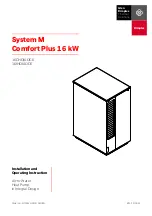
ENGLISH
30
10.2.
STOPPING
Close the interception device on the delivery pipe. If there is a check device on the delivery pipe, the interception valve
on the delivery side may remain open as long as there is back pressure downstream from the pipe.
If hot water is to be pumped, arrange that the pump can be stopped only after having excluded the source of heat
and let sufficient time elapse to allow the liquid temperature to drop to acceptable values, so as not to create
excessive temperature increases inside the pump body.
For a long period of inactivity, close the interception device on the intake pipe and, if supplied, all the auxiliary
control connections. To guarantee maximum system functionality it will be necessary to arrange for brief running
periods (5 - 10 min) at intervals of 1 to 3 months.
If the pump is removed from the system and stored, proceed as indicated in par.5.1
11. PRECAUTIONS
11.1.
The electropump should not be started an excessive number of times in one hour. The maximum admissible value
is as follows:
TYPE OF PUMP
MAXIMUM NUMBER OF STARTS PER HOUR
THREE-PHASE MOTORS UP TO AND INCLUDING 4 kW
100
THREE-PHASE MOTORS OVER 4 kW
20
11.2. DANGER OF FROST:
When the pump remains inactive for a long time at temperatures of less than 0°C, the
pump body must be completely emptied through the drain cap (26), to prevent possible cracking of the hydraulic
components.
Check that the leakage of liquid does not damage persons or things, especially in plants that
use hot water.
Do not close the drainage cap until the pump is to be used again.
When restarting after long periods of inactivity it is necessary to repeat the operations described above in the
paragraphs
"WARNINGS"
and
"STARTING UP"
.
11.3.
To avoid needless motor overloads, accurately check that the density of the pumped liquid corresponds to that
used in the design phase:
remember that the power absorbed by the pump increases in proportion to the
density of the liquid carried.
12.
MAINTENANCE AND CLEANING
The electropump can only be dismantled by competent skilled personnel, in possession of the
qualifications required by the legislation in force. In any case, all repair and maintenance
jobs must be carried out only after having disconnected the pump from the power mains.
Ensure that it cannot be switched on accidentally.
If the liquid has to be drained to carry out maintenance, ensure that the liquid coming out
cannot harm persons or things, especially in systems using hot water.
The legal requirements on the disposal of any harmful fluids must also be complied with.
After a long period of operation there may be difficulties in removing the parts in contact with
water: to do this, use a special solvent available on the market and, where possible, use a
suitable extractor.
Do not force the parts with unsuitable tools.
12.1. Periodic
checks
In normal operation, the pump does not require any kind of maintenance. However, from time to time it is
advisable to check current absorption, the manometric head with the aperture closed and the maximum flow rate,
which will enable you to have advance warning of any faults or wear. If possible, arrange for programmed
maintenance so that problem-free operation may be ensured with minimum expense and reduced machine down
times, thus avoiding long and costly repairs.
12.2.
Greasing the bearings
12.2.1
Standard version: greased-for-life bearings
The size of the bearings has been calculated to guarantee about 20,000 working hours and they do not require any
maintenance.
12.3. Shaft
seal
The seal on the shaft may be a mechanical seal or a stuffing box seal.
12.3.1. Mechanical
seal
Normally no checking is required. Just ensure that there are no leaks of any kind. If leaks are present, change the
seal as described in par.12.4.2.
Содержание KDN Series
Страница 142: ...137 ...
Страница 143: ...138 ...
















































